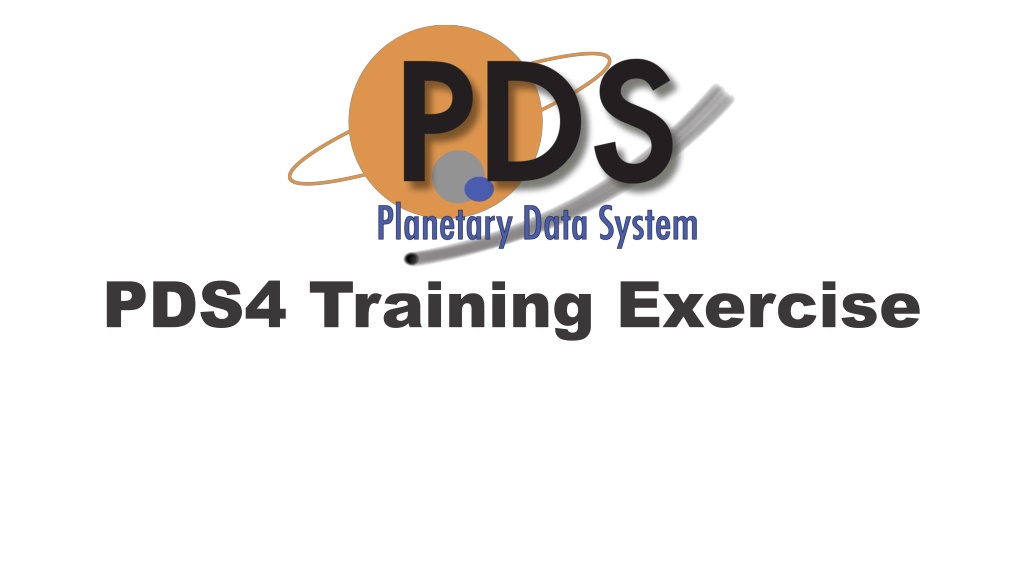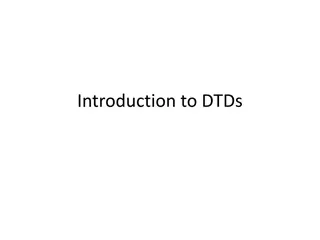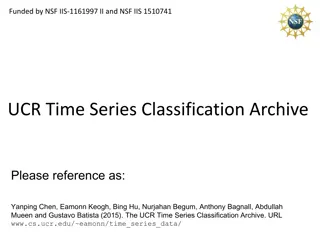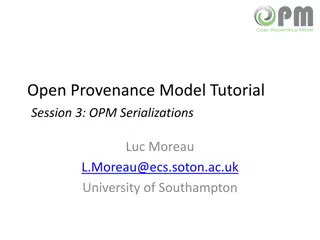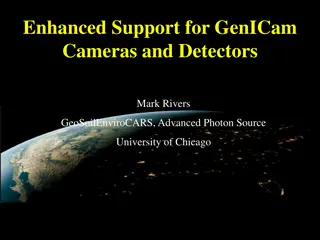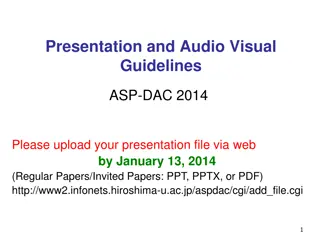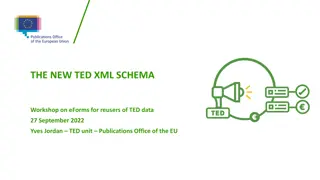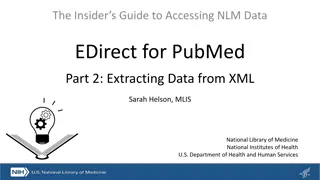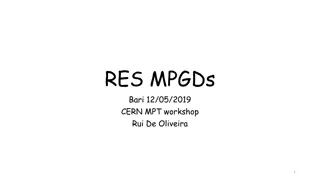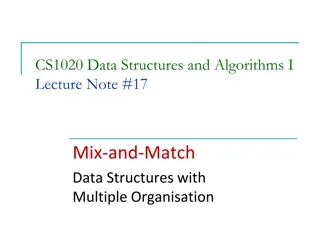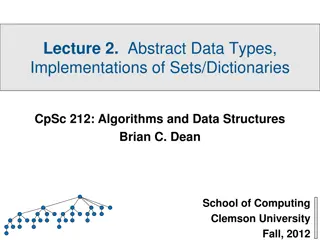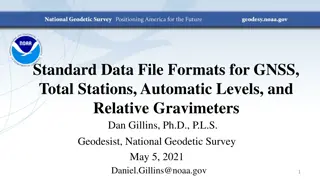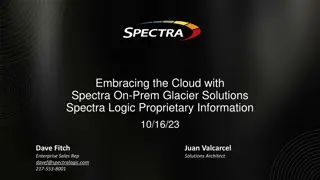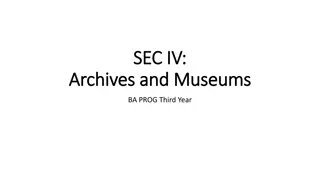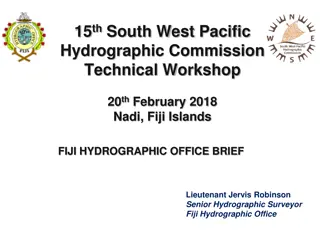Understanding PDS4 Archive Structures and XML Implementation
Explore the key components of a PDS4 archive, including fundamental data structures and XML implementation. Learn about the PDS system, PDS4 standard, and how to produce valid PDS4 archive products. Training materials are available online for further study.
Download Presentation

Please find below an Image/Link to download the presentation.
The content on the website is provided AS IS for your information and personal use only. It may not be sold, licensed, or shared on other websites without obtaining consent from the author. Download presentation by click this link. If you encounter any issues during the download, it is possible that the publisher has removed the file from their server.
E N D
Presentation Transcript
Objectives What you will learn Key components of a PDS4 archive Basic structure of PDS4 metadata What you will do Produce a set of valid PDS4 archive products Training materials are available online: https://pds.jpl.nasa.gov/pds4/training/2017-agu/index.shtml
What are PDS and PDS4? The Planetary Data System (PDS) is NASA s repository for the distribution and long term preservation of NASA planetary data. PDS Archive Planetary Data System The PDS Archive is the digital data repository maintained by PDS. The PDS Standard are requirements and constraints designed to insure the usability of data in the PDS Archive throughout the lifetime of the archive. PDS4 is the latest version of the PDS Standard. PDS4 is nota data format! PDS Standard PDS4
Fundamental Data Structures PDS4 archive products must be describable using one of the following fundamental structures: Array homogenous binary structures of 1 to 16 dimensions in which all of the elements have the same data type. Table ASCII or binary data with a repeating record structure made up of fixed-width fields. Parsable Byte Stream ASCII data with a repeating record structure made up of variable width fields separated by a field delimiter (e.g. CSV). Encoded Byte Stream Files formatted according some established standard (e.g. PDF).
PDS4 Implementation PDS4 XML Schema PDS4 XML PDS4 Metadata Schematron The structure and content of PDS4 metadata is defined by a formal Information Model. Model PDS4 is implemented in XML and expressed in terms of XML Schemaand Schematronfiles. Schematron Schema define the metadata structure Schematron provide rule-based constraints on elements and content Schema Information
XML XML refers to the eXtensible Markup Language standard. XML XML is a markup language (similar to HTML). Element values are placed between opening and closing tags There are two types of elements: Attributes simple elements containing values between their tags Classes complex elements consisting of nested hierarchies of attributes and other classes <tag>Value</tag> Value <name>Bob</name> <File> <name>Bob.txt</name> </File> XML is required to be well-formed : A single root class All elements consist of matching start and end tags Start, end, and empty tags must be correctly nested Characters are resticted to UTF-8 (use of < , > , and & is restricted) Element order is prescribed
PDS4 Products PDS Product 1010000 1000100 1010011 0110100 0100001 Archive File Metadata File File Label A file containing PDS4 metadata is called a PDSLabel. A PDS label along with the file or files that it describes constitutes a PDS Product. PDS4 labels are co-located with the files that they describe. All elements of a PDS4 archive are products.
PDS4 Archive Organization There are 3 primary types of products in PDS4: Basic Products are the smallest unit of a PDS4 archive. They consist of an individual label and the associated file or files. Basic Basic Basic Basic Products Products Products Products 1010000 1000100 1010011 0110100 0100001 Collection Collection Collection Products Products Products Related basic products of the same type may be grouped together into a Collection. Bundle Products Related collections may be grouped together into a Bundle.
Basic Products Basic products consist of: One or more archive files A PDS label file describing the content, and as appropriate, the structure of the labeled file or files Each file may contain one or more Digital Objects A digital object is an individual computer data entity (e.g. image, table, spectra) Basic Products 1010000 1000100 1010011 0110100 0100001 0100001 1010000 1000100 1010011 0110100 Basic products may be of many types (data, browse, documents, etc.). Basic products are frequently referred to generically as products .
Collection Products Collection products consist of two files: a Collection Inventory, a CSV file which Collection Product Collection Inventory contains a list of all of the basic products which are members of the collection a PDS label file which contains a description of the basic products contained in the collection, as well as a description of the collection inventory file The collection label file may optionally summarize any metadata contained in the individual member products (e.g. targets, time ranges, etc.).
Bundle Products A bundle product consists primarily of a PDS label file which includes: A list of the collection products which are members of the bundle (included directly in the label) Optional: A summary of metadata contained in the individual member collections (e.g. targets, time ranges, etc.) A bundle product may also include an optional Readme text file Contains an overview of the bundle contents and organization Must either be plain ASCII text or UTF-8 format Bundle Products
Logical Identifiers urn:nasa:pds:bundle:collection:product A Logical Identifier (LID) is a unique ID that may be used to identify and reference any PDS4 product. LIDs must be unique across PDS Formation rules: LIDs take the form of a Uniform Resource Name (URN). Do not specify physical location LIDs have a maximum length of 255 characters (preferably much less). LID segments are delimited by colons. Allowed characters: lower case letters, digits, dash, period, and underscore.
LID Segments urn:nasa:pds:bundle:collection:product urn , agency, and organization are static, but may vary by archiving organization (e.g. urn:esa:psa , urn:jaxa:darts , etc.) bundleis a bundle identifier (e.g. maven-swea-calibrated ) Must be unique across the archiving organization (i.e. PDS, PSA, etc.) collectionis a collection identifier (e.g. data-svy-pad ) Typically begin with the collection type (data, document, etc.) Must be unique within the bundle product is an identifier for the individual product Must be unique within the collection Within the bundle, collection, and product identifiers dash, period, and/or underscore may be used as delimiters. urn:nasa:pds bundle collection product
LID Inheritance The bundle product LID defines the bundle portion of the LID for its member collections. The collection product LID defines the collection portion of the LID for its member basic products Bundle Product Collection Product Basic Product urn:nasa:pds:bundle urn:nasa:pds:bundle:collection urn:nasa:pds:bundle:collection: product
Version Identifiers and LIDVIDs ::vid The product Version Identifier (VID) may be appended to the LID to form a LIDVID. A double colon (::) is the delimiter to separate the VID from the LID. Internal references may be given either as LIDs or LIDVIDs. A LID refers to a product without specifying a specific version. A LIDVID refers unambiguously to a specific version of the referenced product. PDS4 products use a 2 component VID: M.n The major component (M) starts from 1 . The minor component (n) starts from 0 ; resets whenever M is incremented.
LID/LIDVID and Inventories LIDs and LIDVIDs are used to identify a relationship between two PDS4 labeled products. PDS4 inventories are used to identify the products which are members of a bundle or collection. Inventories point from a product to its member products: Bundle inventories point to their member collection products Collection inventories point to their member basic products Bundle Product Collection Product Collection Product Basic Product Basic Product Basic Product Basic Product
LID/LIDVID and Internal References LIDs and LIDVIDs are used to identify a relationship between two PDS4 labeled products. PDS4 Internal References provide links between related PDS4 labeled products. Bundle, collection, and basic products may reference related products of the same type Bundle, and collection may reference relevant basic products (e.g. documents, context products, etc.) Internal References are not used to indicate membership. Bundle Product Bundle Product Collection Product Collection Product Basic Product Basic Product
Context Products Context products define LIDs for physical or conceptual objects which are not physically part of the PDS archive (e.g. institutions, missions, spacecraft, instruments, targets, etc.). Provide the ability to associated data and other types of products to each of these entities Not designed to be user documentation Maintained by the PDS Engineering Node Data providers should work through the Discipline Nodes obtain or create relevant context products.
Archive Design There is no hard and fast rule governing how a PDS4 archive is to be organized. Data providers may want to consider the following questions: What organization makes sense for the data? What are other data providers on the project planning to do? What are data users likely to find the most useful? Consult with your curating node! Bundle I Collection B Collection A Collection C Bundle II Collection F Collection D
Anatomy of a PDS4 Label XML Declaration XML Declaration XML identification tag; Schematron identification (optional) Product Tag Root tag; Namespace declarations; Schema identification Identification Area Product identifying information Observation/Context Area Product provenance/background Reference List Product (Root) Tag Identification Area Observation/Context Area Reference List Links to relevant products and publications File Area File Area File format and/or structural information
XML Declaration XML Declaration XML Declaration XML identification tag Schematron location information (optional) Product (Root) Tag Identification Area Observation/Context Area <?xml version="1.0" encoding="UTF-8"?> <?xml-model href="http://pds.nasa.gov/pds4/pds/v1/PDS4_PDS_1400.sch" schematypens="http://purl.oclc.org/dsdl/schematron"?> Reference List File Area <?xml-model href="http://pds.nasa.gov/pds4/mission/mvn/v1/PDS4_MVN_1030.sch" schematypens="http://purl.oclc.org/dsdl/schematron"?>
Product Tag Product Tag Root product type tag Namespace declarations Schema location information XML Declaration Product (Root) Tag Identification Area Observation/Context Area <Product_Observational xmlns="http://pds.nasa.gov/pds4/pds/v1" xmlns:xsi="http://www.w3.org/2001/XMLSchema-instance" xmlns:mvn="http://pds.nasa.gov/pds4/mission/mvn/v1" xsi:schemaLocation=" http://pds.nasa.gov/pds4/pds/v1 http://pds.nasa.gov/pds4/pds/v1/PDS4_PDS_1400.xsd Reference List File Area http://pds.nasa.gov/pds4/mission/mvn/v1 http://pds.nasa.gov/pds4/mission/mvn/v1/PDS4_MVN_1030.xsd ">
Identification Area Identification Area Contains product identifying information LID & VID definition Authorship/citation information (optional) Product modification history (optional) XML Declaration Product (Root) Tag Identification Area <Identification_Area> <logical_identifier>urn:nasa:pds:maven.swea.calibrated:data.svy_3d: mvn_swe_l2_svy3d_20170208</logical_identifier> <version_id>3.6</version_id> <title>MAVEN SWEA Survey Rate 3D Electron Distributions for 2017-02- 08</title> <information_model_version>1.4.0.0</information_model_version> <product_class>Product_Observational</product_class> <Citation_Information/> <Modification_History/> </Identification_Area> Observation/Context Area Reference List File Area
Observation/Context Area Observation/Context Area Contains product provenance/background Observation time Scientific content description (science discipline, data processing level, wavelength range, etc.) Target Source (mission, observatory, instrument, etc.) Discipline specific metadata (image display settings, geometry, etc.) Mission specific metadata XML Declaration Product (Root) Tag Identification Area Observation/Context Area Reference List File Area
Reference List (optional) Reference List XML Declaration Contains links to other PDS4 products (by LID/LIDVID) and external publications Product (Root) Tag Identification Area <Reference_List> <Internal_Reference> <lidvid_reference>urn:nasa:pds:maven.spice: spice_kernels:sclk_mvn_sclkscet_00043.tsc::1.0 </lidvid_reference> <reference_type>data_to_spice_kernel </reference_type> <comment> This data file was processed using the SPICE MAVEN SCLK kernel: MVN_SCLKSCET.00043.tsc. </comment> </Internal_Reference> </Reference_List> Observation/Context Area Reference List File Area
File Area File Area XML Declaration Contains a description of the file File name File statistical information (optional: size, creation date, MD5 checksum) File format information Data file structural information Array element descriptions Table record and field descriptions Product (Root) Tag Identification Area Observation/Context Area Reference List File Area
File Area File Area XML Declaration File descriptive information Product (Root) Tag Identification Area <File_Area_Observational> <File> <file_name>mvn_mag_l2_2017061pc1s_20170302_v01_r01.sts</file_name> <md5_checksum>d450c2d5c3774b61b835af11d84389eb</md5_checksum> <comment>This file contains vector magnetic field data acquired by the Fluxgate Magnetometer instrument aboard the MAVEN spacecraft. The data are calibrated and provided in physical units (nT). The data has been downsampled to 1 second to provide a more compact dataset. The data are expressed in Planetocentric coordinates. </comment> </File> Observation/Context Area Reference List File Area
File Area File Area XML Declaration Data structure: Fixed width ASCII table Product (Root) Tag <Table_Character> <offset unit="byte">112348</offset> <records>11670</records> <record_delimiter>Carriage-Return Line-Feed</record_delimiter> <Record_Character> <fields>235</fields> <groups>0</groups> <record_length unit="byte">3765</record_length> <Field_Character> <name>Time (UTC/SCET)</name> <field_location unit="byte">1</field_location> <data_type>ASCII_Date_Time_YMD</data_type> <field_length unit="byte">19</field_length> </Field_Character> Identification Area Observation/Context Area Reference List File Area
File Area Data structure: Array (CDF) XML Declaration <Array> <name>diff_en_fluxes</name> <local_identifier>diff_en_fluxes</local_identifier> <offset unit="byte">132880646</offset> <axes>4</axes> <axis_index_order>Last Index Fastest</axis_index_order> <description>Calibrated differential energy flux</description> <Element_Array> <data_type>IEEE754MSBSingle</data_type> <unit>eV/[eV cm^2 sr s]</unit> </Element_Array> <Axis_Array> <axis_name>time</axis_name> <elements>5400</elements> <sequence_number>1</sequence_number> </Axis_Array> <Axis_Array> <axis_name>elevation angle</axis_name> <elements>6</elements> <sequence_number>2</sequence_number> </Axis_Array> Product (Root) Tag Identification Area Observation/Context Area Reference List File Area
File Area Data structure: Array (FITS) XML Declaration <Header> <local_identifier>header_detector_dark_subtracted</local_identifier> <offset unit="byte">910080</offset> <object_length unit="byte">2880</object_length> <parsing_standard_id>FITS 3.0</parsing_standard_id> </Header> <Array_3D_Spectrum> <local_identifier>data_detector_dark_subtracted</local_identifier> <offset unit="byte">912960</offset> <axes>3</axes> <axis_index_order>Last Index Fastest</axis_index_order> <Element_Array> <data_type>IEEE754MSBSingle</data_type> </Element_Array> <Axis_Array> <axis_name>Time</axis_name> <elements>22</elements> <sequence_number>1</sequence_number> </Axis_Array> <Axis_Array> <axis_name>Line</axis_name> <elements>50</elements> <sequence_number>2</sequence_number> </Axis_Array> <Axis_Array> <axis_name>Sample</axis_name> <elements>40</elements> <sequence_number>3</sequence_number> </Axis_Array> </Array_3D_Spectrum> Product (Root) Tag Identification Area Observation/Context Area Reference List File Area
PDS4 Build-A-Bundle Exercise 1) Archive Bundle Organization Design 2) Define Bundle and Collection Identifiers Bundle and collection LID definition Basic product LID formation rule 3) Generate Document and Document Collection Products 4) Generate Data and Data Collection Product Labels 5) Generate Bundle Readme and Label Files
Most Important Component COMMUNICATION! Make certain to identify the PDS Discipline Node that will be curating your archive early in the process and communicate with them regularly!
PDS Discipline Node Contacts Atmospheres Node Lynn Neakrase +1(575)646-1862 lneakras@nmsu.edu Ring-Moon Systems Mitch Gordon mgordon@seti.org Small Bodies Anne Raugh raugh@astro.umd.edu Jesse Stone jstone@psi.edu Cartography and Imaging Sciences Lisa Gaddis lgaddis@usgs.gov Geosciences Ed Guinness guinness@wunder.wustl.edu Susie Slavney slavney@wunder.wustl.edu International Agency Contacts Data ARchives and Transmission System (JAXA) NAIF (SPICE) Boris Semenov boris.semenov@jpl.nasa.gov Planetary Science Archive (ESA) Santa Martinez Santa.Martinez@sciops.esa.int Planetary Plasma Interactions Joe Mafi jmafi@igpp.ucla.edu
Evaluation Thank you for participating in our PDS4 training exercise. We would really appreciate your feedback on the quick survey below. Your answers are anonymous and are helpful to the development and improvement of our future training sessions. http://bit.ly/LPSC18_PDStrainingsurvey Thank you for your time!
PDS4 Basic Product Types Observational Science data that can be described using one of the fundamental data structures (may not be strictly observational, e.g. calibration tables, etc.) Browse Low resolution products, not suitable for science Document Products describing the science data (includes figures, tables, etc.) Text File Plain ASCII text file SPICE Kernel NAIF SPICE products Thumbnail Lower resolution browse products XML Schema XML Schema or Schematron products Context Products describing physical or conceptual objects. Ancillary Supplementary data which cannot be associated with one of the other data types. Native Products in the original format returned by the observing system, but which cannot be described using one of the 4 fundamental data structures.
PDS4 Collection Types PDS4 defines the following types of collections, loosely corresponding to the basic product types: Collection Type Basic Product Type(s) Description Data Observational, Native Science and native formatted data products Browse Browse, Thumbnail Quick-look products Calibration Observational, Document, Text Products associated with the calibration of basic products Document Document Document products Geometry Observational, Document Non-SPICE geometry products Miscellaneous Any Products not falling under any of the other categories SPICE Kernel Spice Kernel SPICE kernels XML Schema XML Schema Schema and Schematron products Context Context Context products
LID Bundle Identifier bundle Must be unique within PDS Bundle identifiers typically take the form: mission-instrument[-description] mission = The mission ID instrument = The instrument ID description = A description (optional) to help to distinguish the bundle from others from the same mission and instrument Examples: ladee_nms, maven-swea-calibrated
LID Collection Identifier collection Must be unique within the bundle Starts with the collection_type value (lowercase) Collection identifiers typically take the form: collection_type[-description] collection_type = collection_type value (i.e. data, document, etc.) description = A description (optional) to help to distinguish the collection from others of the same type within the bundle (e.g. data type, mission phase, etc.) Examples: data, data_calibrated, data-svy-3d
LID Product Identifier product Must be unique within the collection Typically consists of the base file name of the labeled file Examples: nms_cal_hk__36127_20131203_104228, mvn_swe_l2_svy3d_20161208 Design notes: Uppercase characters must be converted to lowercase. File version numbers, and other variable portions of the file name should be omitted from the product identifier.
Archive Generation Procedure Product planning and design should go from top down: Collections inherit the bundle ID from the LID of their parent bundle; basic products inherit the bundle and collections IDs from their parent bundle and collection. Bundle Products Collection Products Basic Products Product generation should go from bottom up: LIDs need to be harvested for collection and bundle inventories, and other basic product metadata should to be summarized in collection and bundle labels. Basic Products Collection Products Bundle Products
Anatomy of a PDS4 Label Identification Area Citation_Information (required for bundle and collection products, optional for basic products) Provides information required to enable PDS archive products to be cited in scientific publications description element provides a terse product description, rather than a full citation description XML Declaration Product (Root) Tag Identification Area Observation/Context Area <Citation_Information> <author_list>Mitchell, D. L.</author_list> <publication_year>2017</publication_year> <keyword>Electrons</keyword> <description> MAVEN SWEA electron energy/angle (3D) distributions in units of differential energy flux (eV/cm**2 sec ster eV) at the MAVEN survey telemetry rate for 2017-02-08 </description> </Citation_Information> Reference List File Area
Anatomy of a PDS4 Label Identification Area Modification_History (optional) Provides a description of past versions a product XML Declaration Product (Root) Tag Identification Area Observation/Context Area <Modification_History> <Modification_Detail> <modification_date>2017-09-08</modification_date> <version_id>3.6</version_id> <description> MAVEN Release 10 </description> </Modification_Detail> </Modification_History> Reference List File Area
Observation/Context Area Time_Coordinates (required for Observation_Area, optional for Context_Area) Observation/Context Area <Time_Coordinates> <start_date_time>2017-02-08T00:00:10.520Z</start_date_time> <stop_date_time>2017-02-08T23:59:54.991Z</stop_date_time> </Time_Coordinates>
Observation/Context Area Primary_Result_Summary (optional) provides information on the scientific content of the product to enhance data discovery. Parameters include: purpose: Science, Calibration, Engineering, etc. processing_level: Raw, Calibrated, Derived, etc. wavelength_range: Infrared, Near Infrared, Visible, Ultraviolet, etc. domain: Atmosphere, Ionosphere, Magnetosphere, Surface, Interior, etc. discipline_name: Atmospheres, Fields, Imaging, Particles, Small Bodies, etc. facet1: 2D, Color, Grayscale, Ions, Neutrals, Spectral Cube, etc. facet2: Background, Waves, Cosmic Ray, Energetic, Solar Energetic, etc. Observation/Context Area
Observation/Context Area Primary_Result_Summary example Observation/Context Area <Primary_Result_Summary> <purpose>Science</purpose> <processing_level>Calibrated</processing_level> <Science_Facets> <domain>Magnetosphere</domain> <discipline_name>Particles</discipline_name> <facet1>Electrons</facet1> <facet2>Solar Energetic</facet2> </Science_Facets> </Primary_Result_Summary>
Observation/Context Area Investigation_Area (required for Observation_Area, optional for Context_Area) Values include: Individual Investigation, Mission, Observing Campaign, Other Investigation Observation/Context Area <Investigation_Area> <name>Mars Atmosphere and Volatile EvolutioN Mission</name> <type>Mission</type> <Internal_Reference> <lid_reference>urn:nasa:pds:context:investigation:mission.maven </lid_reference> <reference_type>data_to_investigation</reference_type> </Internal_Reference> </Investigation_Area>
Observation/Context Area Observing_System (required for Observation_Area, optional for Context_Area) Used to identify all of the components of the system used to make the observation. Observing_System_Component types: Airborne Aircraft Artificial Illumination Balloon Facility Instrument Laboratory Observation/Context Area Literature Search Naked Eye Observatory Spacecraft Suborbital Rocket Telescope
